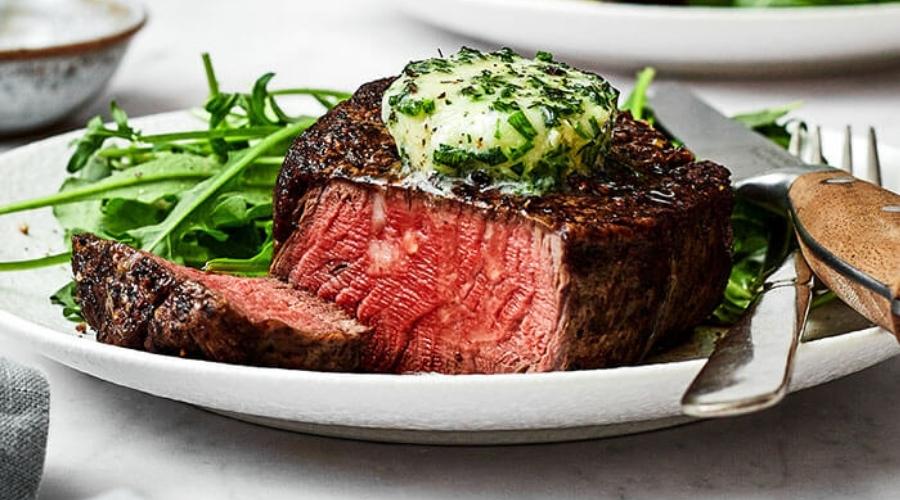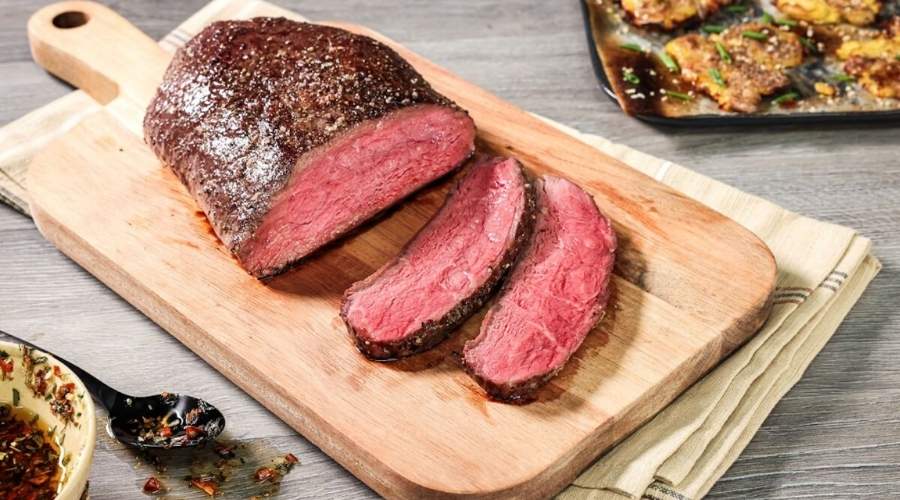Beef Wellington is the epitome of elegance and sophistication, celebrated for its tender beef tenderloin wrapped in mushroom duxelles and golden puff pastry. However, not everyone may have access to or prefer using beef tenderloin.
Whether you’re looking for a more budget-friendly option, a different flavor profile, or a suitable choice for dietary restrictions, there are numerous alternatives that can stand in for beef tenderloin in this classic dish.
In this blog, we’ll explore over a dozen viable substitutes that can help you create a delicious and impressive Beef Wellington, regardless of your preferences or ingredient availability.
12+ Creative Substitutes for Beef Tenderloin in Beef Wellington
With these 12+ alternatives, you can create a dish that not only meets your ingredient preferences but also delights your guests with its taste and presentation.
Embrace the versatility of these substitutes and discover how you can put your own spin on this classic dish, making it perfect for any occasion.
Beef Tenderloin Roast
A beef tenderloin roast is a suitable substitute for beef Wellington if you’re looking for a similar cut of meat but with a slightly different presentation.
This cut is also known for its tenderness and mild flavor, making it a great option.
The main difference is that a tenderloin roast is often larger and can be used in dishes that don’t require the same precise size as individual portions of beef Wellington.
When using this substitute, ensure you adjust cooking times according to the size of the roast.
This cut is ideal for recipes that call for a large centerpiece roast rather than individual filets, such as a holiday dinner or a special occasion meal.
Filet Mignon

Filet mignon is another excellent substitute for beef Wellington, offering a similar level of tenderness and flavor.
This cut is essentially a smaller portion of the tenderloin, making it perfect for individual servings.
When substituting filet mignon, you can follow the same preparation methods as you would for beef Wellington, including wrapping it in prosciutto and puff pastry.
However, because filet mignon is smaller and cooks faster, you’ll need to adjust cooking times to avoid overcooking.
This option works well for creating individual beef Wellingtons or for a refined steak dinner.
Also Read: 12+ Delicious Substitutes for Calabrian Chile Paste to Elevate Your Cooking!
Pork Tenderloin
Pork tenderloin is a versatile substitute for beef Wellington that offers a different flavor profile but still provides a tender and juicy texture. Although pork tenderloin is not as rich as beef, it can be seasoned and prepared in a similar manner.
For recipes calling for beef Wellington, you can use pork tenderloin wrapped in a mushroom duxelles and puff pastry.
Keep in mind that pork tenderloin cooks faster than beef tenderloin, so adjust cooking times accordingly. This substitute is suitable for those seeking a lighter alternative or who prefer pork over beef.
Chicken Breast
For a lighter and more affordable option, chicken breast can serve as a substitute for beef Wellington.
While it lacks the richness of beef, chicken breast can be dressed up with a mushroom duxelles and wrapped in puff pastry to mimic the classic presentation.
Since chicken breast cooks more quickly than beef, be careful not to overcook it to ensure it remains juicy.
This substitute is ideal for a budget-friendly or healthier version of Wellington and works well for serving larger groups or family dinners.
Chuck Roast
Chuck roast is a hearty and flavorful cut of beef that can be used as a substitute for beef Wellington, especially if you’re looking for a more economical option.
This cut is less tender than beef tenderloin but has a robust flavor that can be enhanced with a well-seasoned mushroom duxelles and a crisp puff pastry wrap.
Because chuck roast is tougher, it requires longer cooking times to become tender, so you may need to adjust your recipe accordingly. This substitute is best suited for a rustic, comforting meal where you can enjoy a rich beef flavor without the higher cost of tenderloin.
Top Sirloin

Top sirloin is a flavorful cut that works well as a substitute for beef Wellington when you want a balance between tenderness and cost. It’s less expensive than tenderloin but still offers a good texture and taste.
When using top sirloin, be sure to trim any excess fat and consider marinating or seasoning it to enhance the flavor.
Like with beef tenderloin, wrap it in prosciutto and puff pastry to replicate the traditional Wellington experience.
Adjust the cooking time to ensure that the meat is cooked to your desired level of doneness, making it a suitable option for a more affordable yet satisfying meal.
Also Read: 12+ Easy Substitutes for Fresh Lemon Juice in Cooking and Baking!
Lamb Rack
A rack of lamb can serve as an elegant substitute for beef Wellington, offering a unique and flavorful alternative.
The tender and juicy nature of lamb pairs well with the mushroom duxelles and puff pastry, providing a sophisticated twist on the classic dish.
When using lamb rack, be mindful of the different cooking times and temperatures compared to beef tenderloin.
Lamb typically cooks faster and has a stronger flavor, so adjust your recipe to ensure the lamb is perfectly cooked.
This substitute is ideal for special occasions or dinner parties where you want to impress with a gourmet variation of Wellington.
Seitan
For a vegetarian or plant-based alternative, seitan can be used as a substitute for beef Wellington. Seitan, made from wheat gluten, has a texture similar to meat and can be seasoned and prepared to mimic the richness of beef.
To use seitan, wrap it in a mushroom duxelles and puff pastry, just like the traditional beef Wellington.
While seitan doesn’t offer the exact same flavor as beef, it provides a satisfying and hearty option for those avoiding animal products.
Be sure to adjust seasoning and cooking times to suit the texture and flavor of the seitan, making it a suitable choice for vegan or vegetarian versions of Wellington.
Veal Tenderloin
Veal tenderloin is a premium substitute for beef Wellington that provides a delicate and tender alternative to beef.
The mild flavor of veal complements the mushroom duxelles and puff pastry beautifully, making it an elegant choice for special occasions.
Veal tenderloin cooks similarly to beef tenderloin but tends to be even more tender.
As with beef Wellington, be sure to adjust cooking times to avoid overcooking, as veal can dry out more quickly than beef. This substitute is perfect for those looking to create a refined and luxurious version of the classic dish.
Pork Loin
Pork loin is a versatile and budget-friendly alternative to beef Wellington.
This cut of meat is larger and can be used for both individual servings and a whole roast. While pork loin is not as tender as beef tenderloin, it can be made flavorful with proper seasoning and a mushroom duxelles wrap.
Be mindful of cooking times, as pork loin generally requires a longer cook than beef tenderloin.
This substitute is ideal for those seeking a more affordable option while still delivering a satisfying and flavorful dish.
Turkey Breast

Turkey breast is a lean and healthy substitute for beef Wellington. It offers a mild flavor that pairs well with mushroom duxelles and puff pastry, though it is less rich than beef.
To ensure the turkey breast remains moist, consider brining it before cooking.
As turkey breast cooks faster than beef tenderloin, you will need to adjust the cooking time to avoid dryness.
This alternative is well-suited for those looking to prepare a lighter version of Wellington or for holiday dinners where turkey is a preferred protein.
Vegetable-Stuffed Portobello Mushrooms
For a completely plant-based option, large portobello mushrooms stuffed with a mixture of vegetables and herbs can serve as a creative substitute for beef Wellington.
The meaty texture of portobello mushrooms makes them a suitable stand-in, and the stuffing can be tailored to include ingredients like spinach, garlic, and onions.
Wrap the stuffed mushrooms in puff pastry to achieve a similar presentation to the traditional Wellington.
This option is ideal for vegetarian or vegan diners who want to enjoy a dish with the same visual appeal and flavor complexity as the classic beef Wellington.
Also Read: 12+ Delicious Low-Calorie Replacements for Heavy Cream in Your Favorite Dishes!
How to Make Beef Wellington Tenderloin Substitute at Home
Creating a tenderloin substitute for beef Wellington at home can be a rewarding culinary endeavor, especially if you want to offer a variety of options or adapt to dietary preferences.
This recipe provides a detailed guide on preparing a delicious alternative using pork tenderloin.
The pork tenderloin is seasoned, wrapped in a flavorful mushroom duxelles, and encased in puff pastry, mimicking the traditional beef Wellington’s texture and presentation.
This substitute is perfect for those looking to enjoy a similar experience to beef Wellington with a different cut of meat.
Ingredients:
- 1.5 pounds pork tenderloin
- Salt and black pepper, to taste
- 2 tablespoons olive oil
- 1 cup finely chopped mushrooms (button or cremini)
- 1 small shallot, finely chopped
- 2 cloves garlic, minced
- 1/4 cup dry white wine (optional)
- 1 tablespoon fresh thyme leaves (or 1 teaspoon dried thyme)
- 1/2 cup pâté (optional, for extra richness)
- 1 sheet puff pastry, thawed
- 1 egg, beaten (for egg wash)
- 2 tablespoons Dijon mustard
Instructions:
- Prepare the Pork Tenderloin: Preheat your oven to 400°F (200°C). Season the pork tenderloin generously with salt and black pepper. In a skillet over medium-high heat, heat the olive oil and sear the pork on all sides until browned, about 2-3 minutes per side. Remove from heat and let cool.
- Make the Mushroom Duxelles: In the same skillet, add the finely chopped mushrooms, shallot, and garlic. Cook over medium heat until the mushrooms release their moisture and become golden brown, about 10 minutes. If using, deglaze the pan with white wine and cook until the liquid evaporates. Stir in the thyme and cook for an additional minute. Remove from heat and let cool.
- Assemble the Wellington: Roll out the puff pastry on a lightly floured surface. Spread a thin layer of Dijon mustard over the pork tenderloin. If using pâté, spread it evenly over the pork. Next, spread the mushroom duxelles over the mustard or pâté layer. Place the pork tenderloin in the center of the puff pastry.
- Wrap the Pork: Fold the puff pastry over the pork, sealing the edges by pinching them together. Brush the seam and edges with beaten egg to ensure they seal properly. Place the wrapped pork seam-side down on a baking sheet lined with parchment paper.
- Bake: Brush the top of the puff pastry with the remaining beaten egg. Bake in the preheated oven for 25-30 minutes, or until the pastry is golden brown and the internal temperature of the pork reaches 145°F (63°C). Let it rest for 10 minutes before slicing.
This recipe for making a beef Wellington tenderloin substitute using pork tenderloin offers a flavorful and elegant alternative to the traditional dish.
By incorporating a rich mushroom duxelles and encasing the pork in a golden puff pastry, you achieve a dish with a similar presentation and texture to beef Wellington.
Pork tenderloin, while less expensive and less rich than beef tenderloin, provides a satisfying and tender option that is perfect for a variety of occasions, from weeknight dinners to special celebrations.
By following these steps, you can enjoy a delectable and impressive meal that brings a fresh twist to a classic recipe.
1. What can I use as a substitute for beef tenderloin in Beef Wellington?
You can use several alternatives to beef tenderloin in Beef Wellington.
Options include pork tenderloin, lamb rack, veal tenderloin, or even seitan for a vegetarian choice. Each substitute offers its own unique flavor and texture.
Pork tenderloin provides a similar texture and is more economical, while lamb rack adds a gourmet touch.
Veal tenderloin is a more delicate option, and seitan is ideal for a plant-based version. Adjust cooking times based on the substitute to ensure it is cooked to your preference.
2. How do I cook pork tenderloin as a substitute for beef tenderloin in Beef Wellington?
To cook pork tenderloin as a substitute, season it with salt and pepper, then sear it on all sides in a hot pan until browned.
Prepare your mushroom duxelles and spread it over the seared pork. Wrap the pork in puff pastry, brush with egg wash, and bake in a preheated oven at 400°F (200°C) for 25-30 minutes, or until the pastry is golden and the internal temperature of the pork reaches 145°F (63°C). Allow the Wellington to rest before slicing.
3. Can I use lamb rack as a substitute for beef tenderloin in Beef Wellington?
Yes, lamb rack can be a great substitute for beef tenderloin in Beef Wellington. The rich flavor of lamb complements the mushroom duxelles and puff pastry well.
To prepare, season the lamb rack, sear it, and wrap it with mushroom duxelles and puff pastry.
Adjust the cooking time, as lamb cooks faster than beef tenderloin. Bake until the pastry is golden and the lamb reaches your desired level of doneness.
4. Is there a vegetarian substitute for beef tenderloin in Beef Wellington?
Yes, seitan is an excellent vegetarian substitute for beef tenderloin in Beef Wellington. It has a meaty texture and can be seasoned to mimic the flavor of beef.
Prepare seitan by wrapping it with mushroom duxelles and puff pastry, just like the traditional recipe. Bake until the pastry is golden brown and the seitan is heated through.
Adjust seasoning to ensure the flavor is rich and satisfying.
5. How do I adjust cooking times when using different substitutes for beef tenderloin in Beef Wellington?
When using substitutes like pork tenderloin, lamb rack, or veal tenderloin, you need to adjust cooking times based on the meat’s characteristics.
Pork tenderloin typically cooks faster than beef tenderloin, while lamb rack usually requires less time.
Veal tenderloin is delicate and cooks quickly. For plant-based options like seitan, cook until the puff pastry is golden and the filling is heated through.
Always use a meat thermometer to ensure proper internal temperatures: 145°F (63°C) for pork, and adjust according to your preferred doneness for lamb and veal.
References
- https://www.reddit.com/r/Cooking/comments/zqrv0k/beef_tenderloin_alternative_for_wellington/
- https://www.quora.com/What-other-beef-cuts-can-I-use-to-cook-beef-wellington-other-than-tenderloin
- https://pattyandersonsblog.blogspot.com/2013/03/poor-mans-beef-wellington.html
- https://www.joshuaweissman.com/post/beef-wellington-but-cheaper


